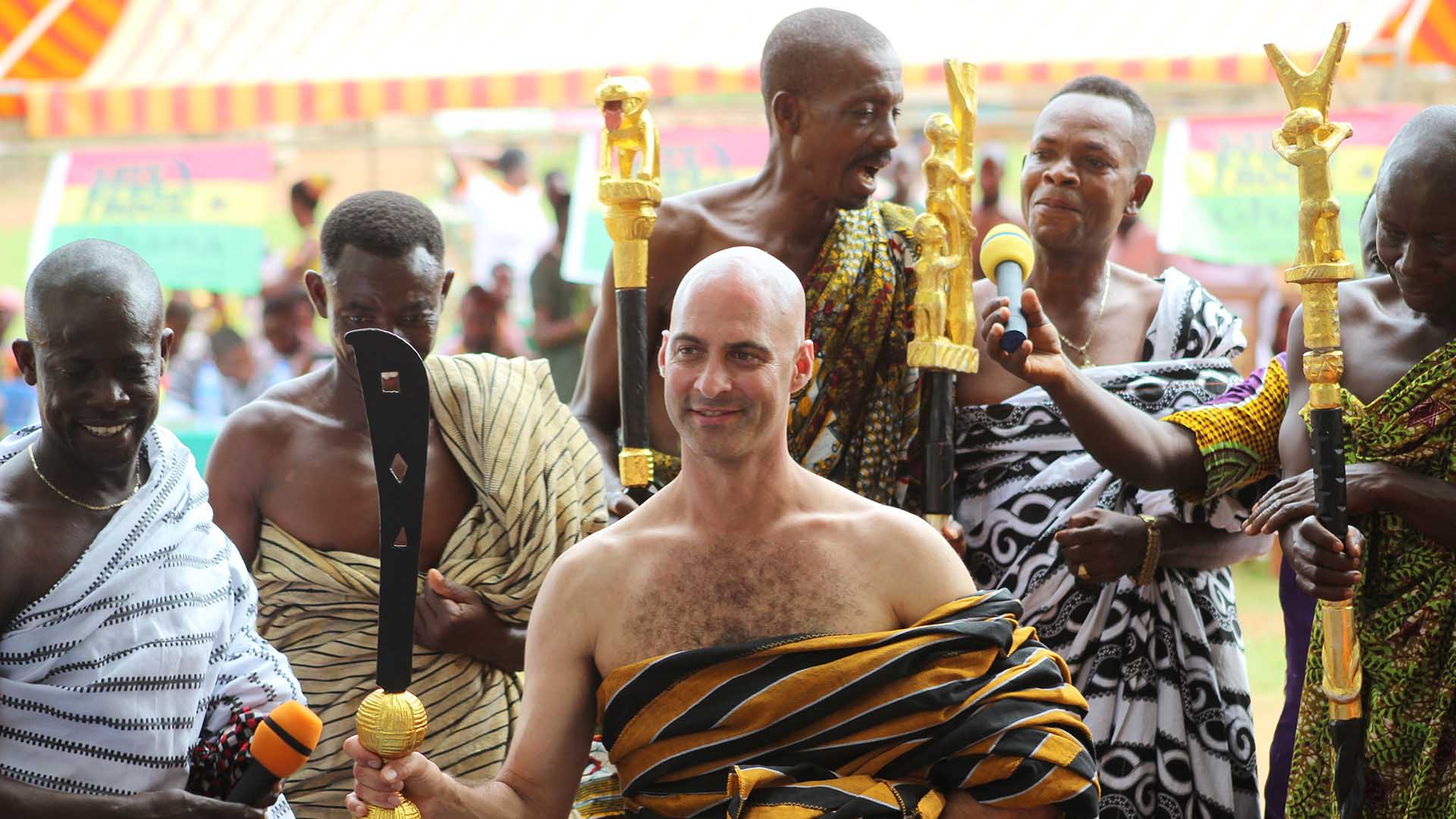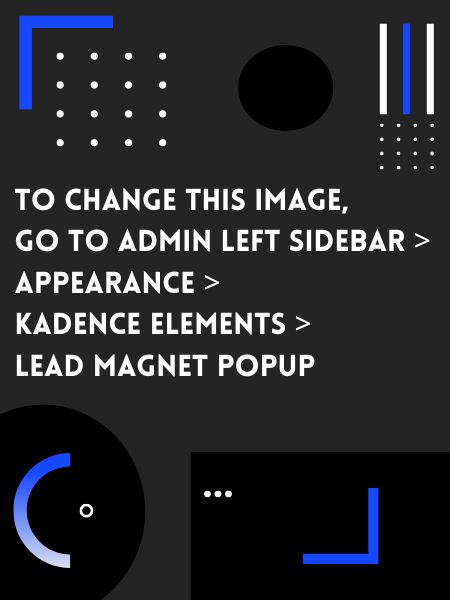SAVE THE FROGS! Founder Dr. Kerry Kriger first traveled to Ghana in September 2011. On that trip he co-founded SAVE THE FROGS! Ghana with amphibian biologist Gilbert Adum. In 2016, Dr. Kriger returned to Ghana to lead the SAVE THE FROGS! Ghana Expedition, a 23-day journey to train volunteers and spread amphibian awareness throughout the country. This is his story of how he became an African chief.
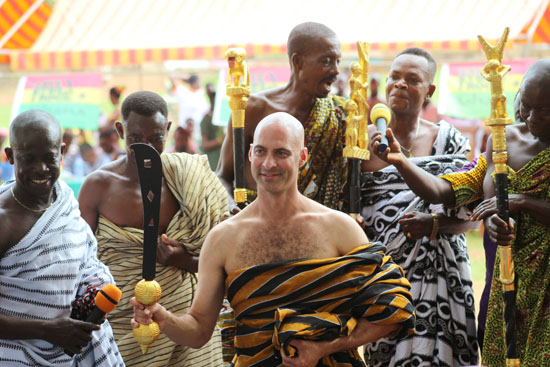
On September 22nd, 2016, SAVE THE FROGS! Founder Dr. Kerry Kriger took a pledge to help the environment and development of the Yawkrom community, and was inducted as chief of environment and development.
Introduction
On the 5th birthday of SAVE THE FROGS! Ghana (September 22nd, 2016), I became a chief in the village of Yawkrom, Western Region, Ghana. A seven hour ceremony took place featuring live drumming, dancing, singing, a brass band, all the village chiefs, members of parliament and numerous presentations on frogs, the environment, empowering students and otherwise improving the community. About 500 people were present – virtually the entire village. SAVE THE FROGS! Ghana Co-Founder Gilbert Adum and I pledged to the chiefs to help the community’s development and environment and we were inducted as chiefs. The paramount chief cut the ribbon on SAVE THE FROGS! Ghana’s brand new Sui Amphibian Conservation Education Center and I pledged a $1,000 donation to the center on behalf of SAVE THE FROGS!. At the end of the ceremonies, Gilbert and I marched away with our fellow chiefs, followed by a brass band, to a house in the village where we shared a bottle of shnapps. Afterwards I gave an interview to the German documentary crew that had been filming our efforts for the past several days. I went to sleep that night to the sound of frogs calling from a plantain field nearby.
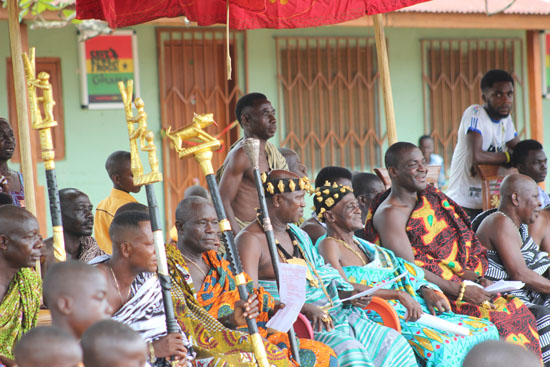
The chiefs of Yawkrom, Ghana sit in front of the brand new Sui Amphibian Conservation Education Centre at the base of the Sui River Forest Reserve.
Yawkrom sits at the base of the Sui River Forest Reserve, which is home to the Giant Squeaker Frog (Arthroleptis krokosua), one of the world’s most endangered amphibians. The rainforests surrounding Yawkrom are a true amphibian biodiversity hotspot, with at least thirty known amphibian species. Unfortunately the Sui rainforests are increasingly under threat from legal and illegal mining, farming, timber collection, hunting and fires. As such, protecting the Sui rainforests and saving the frogs of the Yawkrom region is one of the most significant amphibian conservation challenges in the world – and one of our greatest opportunities to make a significant positive impact.
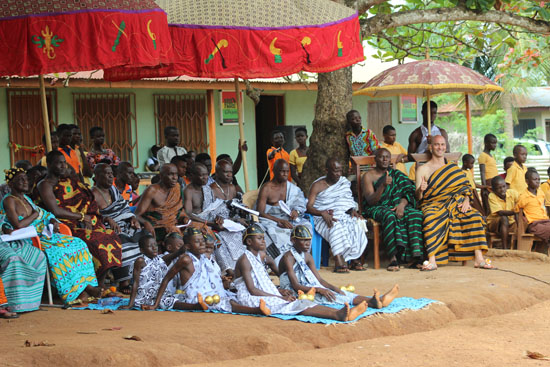
Gilbert Adum (in green) and I sit in a line of 18 chiefs shortly after our installment as chiefs of environment and development.
Before I relate the full story of how Gilbert and I became chiefs, I feel it is necessary to convey the fact that our induction to the chieftancy (which we had not solicited) came about only after five years of sustained efforts on the parts of myself and Gilbert to save Ghana’s frogs and to gain the support of Ghana’s people in our frog saving efforts – all facilitated by the generous support of the SAVE THE FROGS! worldwide community of staff, volunteers and supporters.
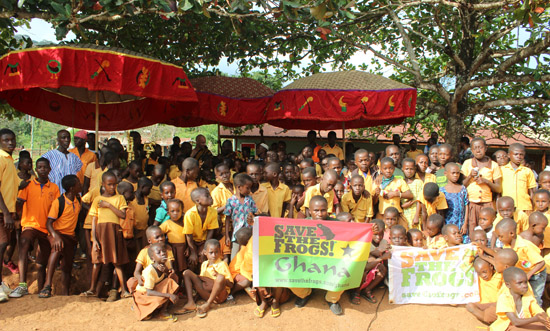
The students of Yawkrom were granted the day off of school so they could attend the celebrations. The building in the background is SAVE THE FROGS! Ghana’s brand new Sui Amphibian Conservation Education Centre.
I must also state the implications of our new chieftancy: the two most important being that Gilbert and I have:
(1) greatly expanded our sphere of influence within the Yawkrom community and thus the Sui River Forest Reserve; and
(2) we have taken on the responsibility to improve not just the health of the rainforest, but also that of the Yawkrom community, which lacks running water, proper sanitation and other basics of life most westerners take for granted. To achieve our goals of improving the environment and the community of Yawkrom, Gilbert and I appreciate your continued support far into the future. Without further ado, enjoy the story!
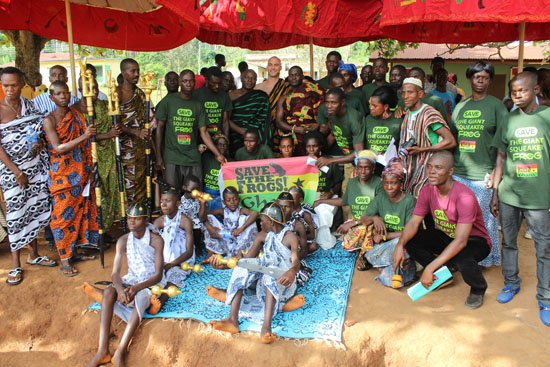
All the details of how Gilbert Adum and I became chiefs
A few hours into the day’s celebrations (which included traditional drumming, dancing, singing and a multitude of presentations on the environment), Gilbert and I were asked to walk over to the Chiefs, who were seated on the opposite side of the event grounds from us. We all shook hands, then walked in a line with the Chiefs into a private room of the new education center. The chiefs pulled out traditional robes (kente) and sandals for me and Gilbert. We removed our shirts and shoes and the Chiefs helped me get my robe on correctly. It took three Chiefs a couple minutes to figure it out, so I hope there’s a YouTube guide to donning a chief robe lest I need to do it myself sometime! The left hand always holds the robe to keep it in place and one shoulder is always left uncovered. After we were properly dressed one of the Chiefs instructed us on the pledge we would soon make: “I pledge to the Nananum (board of Chiefs) to help with the environment and development of the community”. He also showed me how to hold the golden handled sword while reciting the pledge (the sword was of lightweight materials and not a real fighting sword).
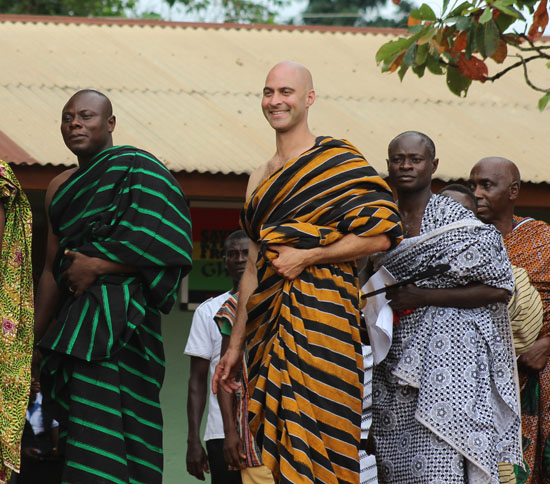
We walked out to the center of the field where the celebrations were taking place. My new name was announced:
(Nana Kojo Agyeman Bosompem Nkosuohene The First).
Nana = Elder
Kojo = Born on Monday
Agyeman = He who fought for the town
Bosompem = Great deity, or thousand gods
Nkosuo = Development
Hene = Chief
Then we turned and walked to within a few meters in front of where the paramount chief (the omanhene) sat. Gilbert went first and gave his pledge.
SAVE THE FROGS! Ghana Co-Founder Gilbert Adum pledges to protect the environment of Yawkrom, and was given the title Nana Kwabena Bosompem Sompahene The First. Sompa means great, selfless, dedicated service.
Then the chief next to me told me it was time for me to step up. I stepped up to the edge of a ditch a few meters in front of the paramount chief (Nana Akwasi Agyemang Bosompem II). The paramount chief recited some statements that I repeated and I made my pledge into the microphone. This took maybe ninety seconds and included statements such as if the Chiefs ever call on me I will come rain or shine (unless I am unhealthy and thus unable to come).
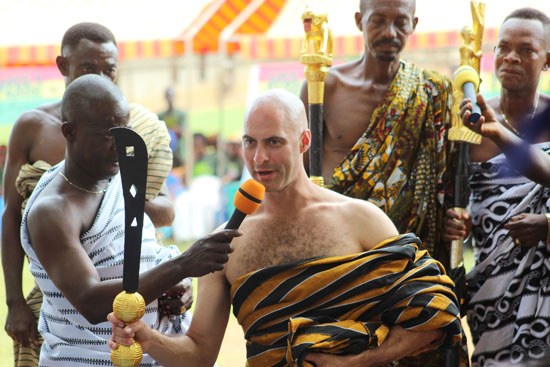
I was instructed to step up to the paramount chief. I crossed the ditch and walked up the middle of the two rows of kids known as “souls”. The souls were dressed in all white and black garb of artistic design and with matching headwear. They looked less than ten years old. Souls are chosen at birth to that position and are always virgins. Eventually when they get too old they are replaced by incoming souls (younger children). There were perhaps eight of them, in two columns of four. I walked up the middle of the souls and stopped in front of the paramount chief. We had a long handshake. I can’t remember what he said. Then I walked to my left, shaking hands and saying thank you to every one of the sixteen Chiefs, all who were seated.

Shaking hands with my fellow chiefs
Then Gilbert and I took seats at the end of the row. A physically fit kid of maybe 16 years old held an umbrella for Gilbert and I for the duration of the day. The sun was hot but we were generally in the shade of a big tree. I didn’t have my camera on me but would have loved it as I was in a line of Chiefs. Some had golden staffs (not likely real gold), each with a different animal at the top.

We sat for a an hour as the rest of the presentations continued. A woman took the mic to solicit donations for the brand new Sui Amphibian Conservation Education Center, which was just a few meters behind us. I walked out and pledged $1,000 on behalf of SAVE THE FROGS!. A very generous donor had specifically contributed this a few hours earlier in response to the fundraising appeal I had sent out that morning.
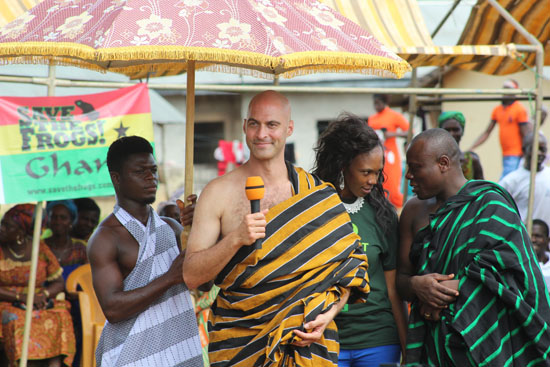
In my first speech as an African chief, I pledged $1,000 on behalf of SAVE THE FROGS! to assist with the Sui Amphibian Conservation Education Centre.
At the end of the presentations, we all walked over to the new education center. The paramount chief cut the rope and ushered in a whole new area of amphibian conservation. We went in with the film crew, lots of kids, the Chiefs, Alex the candidate for Member of Parliament and others. There were five computers with SAVE THE FROGS! stickers on them – the village’s first computers (all recently purchased by SAVE THE FROGS! Ghana) – and a library of kids’ environmental books that STF! Ghana’s Sandra Owusu-Gyamfi had acquired in Accra. I talked to Alex the candidate for Parliament and then walked outside and took photos with the kids. Then Gilbert and I and the chiefs re-gathered. I took a seat immediately beside the paramount chief and a round of photos was had.
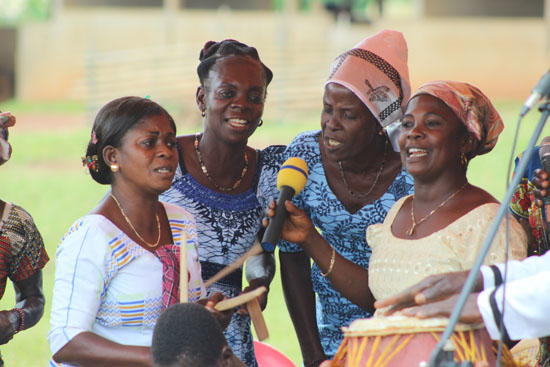
Traditional singers and drummers performed throughout the day
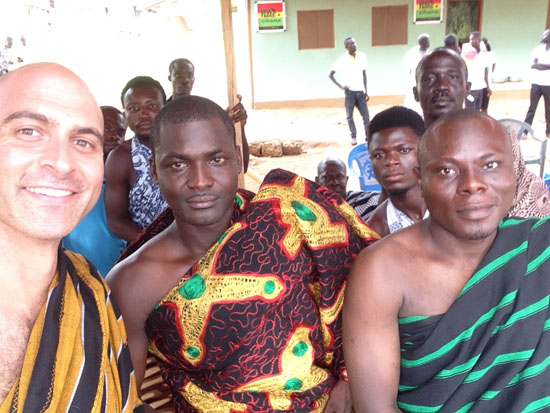
Gilbert Adum and I with the paramount chief of Yawkrom (Nana Akwasi Agyemang Bosompem II).
After the photo session Gilbert and I marched with the Chiefs to “the palace”, followed by the brass band and shaded by the kid who carried our umbrella. The palace was a house that looked like any other in the village, but without trash in the yard, and fairly well-ordered inside. The Nananum (the Chiefs) all sat in a semi-circle in the front yard, me beside the paramount chief. We all had a shot of schnapps. The tradition is to pour a small amount on the ground prior to drinking.
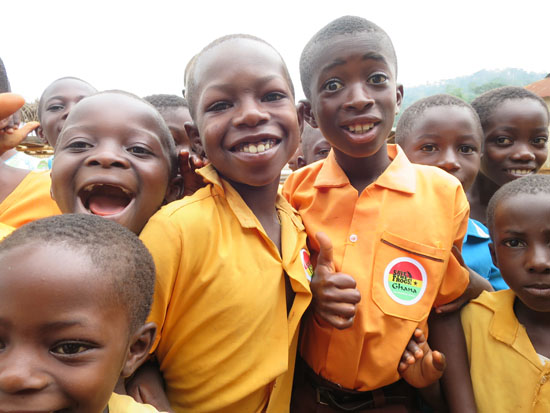
The next generation of frog savers in Yawkrom
I talked for a while with the paramount chief, who explained the meaning of my new name and told me he’d be happy to come to America as an ambassador if I hold an event. He told me that he had been online to read through the SAVE THE FROGS! Ghana website, which made me happy. He mentioned that he had seen the photo of Sandra Owusu-Gyamfi with several of the Yawkrom chiefs (one of my all-time favorite SAVE THE FROGS! photos, see below). The chief in the red hat in that photo was currently sitting next to us; the paramount chief told me it was that chief who had suggested that I be inducted as a chief. I turned to him and thanked him for his support.
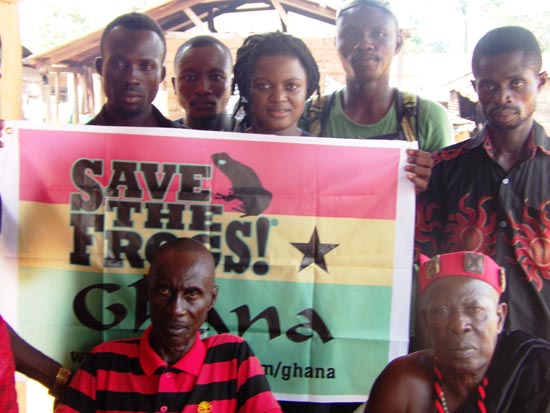
The paramount chief told me he had seen this 2014 photo on our site, and that it was the chief in the red hat who suggested I be installed as a chief.
I asked the paramount chief if he was born in the village. He told me that he was from Kumasi (the second largest city in Ghana) and lived near the SAVE THE FROGS! Ghana offices. He had been chief for just seven months. I was later told that there had been some controversy about him becoming paramount chief as he was an outsider to the village. His grandfather was a famous chief and by virtue of him being a nephew of the former chief, he inherited the omanhene (paramount chieftancy) when his uncle died – chieftancy is matrilineal, going to the son of the sister of the deceased chief. Virtually all chiefs inherited their positions. Generally the only non-hereditary chiefs are development chiefs (such as Gilbert and myself) who have contributed significantly to the community or have the potential and the expectation to contribute significantly in the future. Youth can also be made chiefs if they are deemed exceptional. Regardless of his background, I was happy the paramount chief had visited our website and seemed accepting of our conservation efforts.

Traditional Ghanaian dancers during the SAVE THE FROGS! Ghana 5th birthday celebrations.
Eventually the paramount chief said I could go change out of my robe if I wanted to. I walked in “the palace” and in the back was my shirt, but unfortunately my sandals were missing. I was told I could keep my robe and my new Chief sandals (which were quite uncomfortable). The head of household walked me over to the education center to find my own sandals, which fortunately were still in the room I had walked into just before becoming a chief.

I walked out and the German film crew from Deutsche Wela (DW-TV) was interviewing Gilbert. They asked me for an interview, slightly disappointed I was no longer in my chief attire. After the interview I walked them over to the palace so they could interview the paramount chief. I stayed to hear what he had to say.
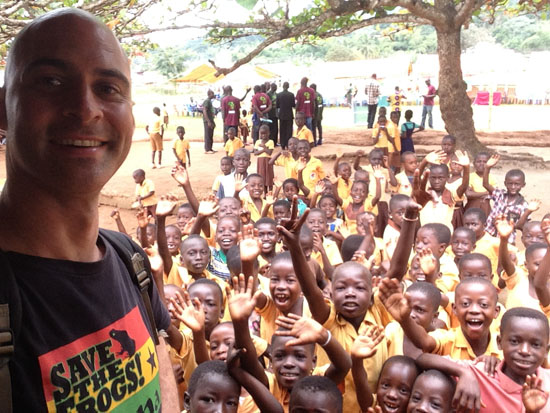
With kids in front of the brand new Sui Amphibian Conservation Education Centre
At the end of the interview I walked with Gilbert to our village host’s house as the rest of our team was there and dinner awaited us. We had dinner with our host family with a view of the Sui hills and rainforest in the distance. Eventually we got into our taxis and drove the dirt road 75 minutes back to the Cocoa Board Lodge in Siefsi Wiawso, where I reminisced about the events of the day and drifted off to sleep to the sounds of frogs calling.
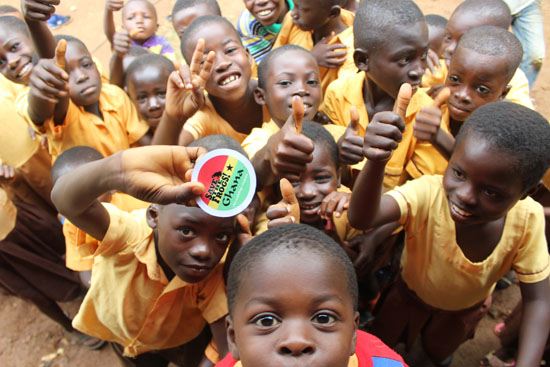
Stay tuned for a lot more photos from the day’s celebrations, as well as an article about my goals as chief of environment and development in Yawkrom, Western Region, Ghana.
You can help out today by donating to our efforts in Ghana. We rely on your support to make amazing things happen for frogs, rainforests and humans. Thank you for helping us SAVE THE FROGS!


